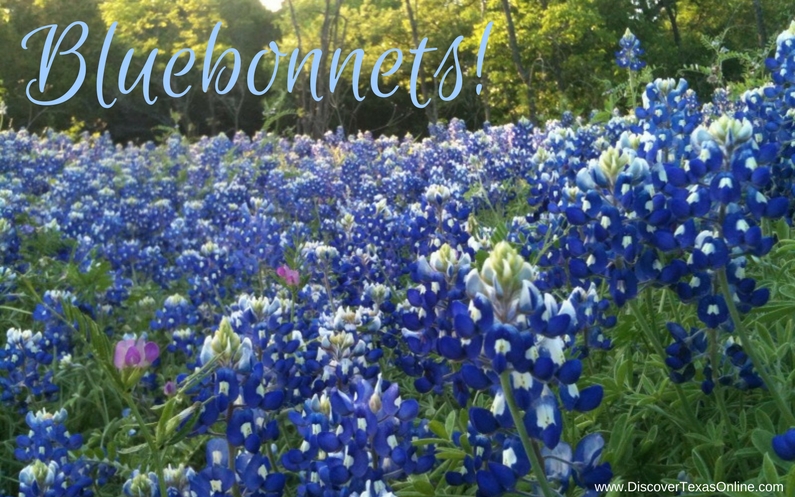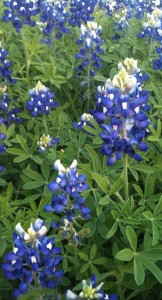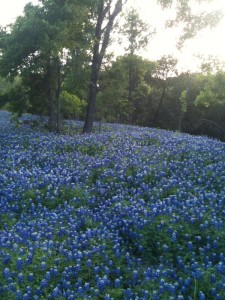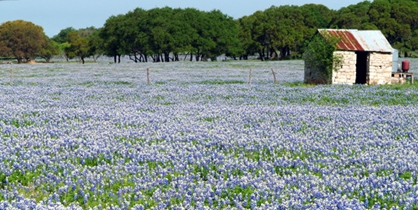
Every Spring, God carpets the state of Texas in blue. But it wasn’t until March 7, 1901 that the Texas legislature adopted the bluebonnet as the official State Flower of Texas.
What interests me, beyond the flat-out stunning beauty of the little wildflower also known as buffalo clover, is that one woman spearheaded the movement to have the humble Texas lupine exalted to this place of honor. She united the efforts of simple citizens and, in the end, won out over more powerful interests.
Did you know that there are five varieties of bluebonnet “officially” recognized as the State Flower?
According to the Texas Cooperative Extension, the five state flowers of Texas are:
 Lupinus subcarnosus, the original champion and still co-holder of the title, grows naturally in deep sandy loams from Leon County southwest to LaSalle County and down to the northern part of Hidalgo County in the Valley. It is often referred to as the sandy land bluebonnet. The plant’s leaflets are blunt, sometimes notched with silky undersides. This species, which reaches peak bloom in late March, is not easy to maintain in clay soils.
Lupinus subcarnosus, the original champion and still co-holder of the title, grows naturally in deep sandy loams from Leon County southwest to LaSalle County and down to the northern part of Hidalgo County in the Valley. It is often referred to as the sandy land bluebonnet. The plant’s leaflets are blunt, sometimes notched with silky undersides. This species, which reaches peak bloom in late March, is not easy to maintain in clay soils.
Lupinus texensis, the favorite of tourists and artists, provides the blue spring carpet of Central Texas. It is widely known as THE Texas bluebonnet. It has pointed leaflets, the flowering stalk is tipped with white (like a bunny’s tail) and hits its peak bloom in late March and early April. It is the easiest of all the species to grow.
Lupinus Havardii, also known as the Big Bend or Chisos Bluebonnet, is the most majestic of the Texas bluebonnet tribe with flowering spikes up to three feet. It is found on the flats of the Big Bend country in early spring, usually has seven leaflets and is difficult to cultivate outside its natural habitat.
Lupinus concinnus is an inconspicuous little lupine, from 2 to 7 inches, with flowers which combine elements of white, rosy purple and lavender. Commonly known as the annual lupine, it is found sparingly in the Trans-Pecos region, blooming in early spring.
Lupinus plattensis sneaks down from the north into the Texas Panhandle’s sandy dunes. It is the only perennial species in the state and grows to about two feet tall. It normally blooms in mid to late spring and is also known as the dune bluebonnet, the plains bluebonnet and the Nebraska Lupine.
TEACHING TIPS:
- Bluebonnets are an ever-popular backdrop for family photos. Make time to do this! Photography is a legitimate art form that could be part of your students’ fine arts education.
- Did you know bluebonnets are biennials? That (plus temperatures and rainfall) explains why we have an abundant show one year and a so-so show the next.
- See who can spot the first blooming bluebonnet! Depending on the weather, the first blooms usually show up in March or early April. Until last year, my personal record sighting was Valentine’s Day when, after a spell of unseasonably warm weather one year, I found a single flower blooming in the warm breeze created by the compressor of our church’s heating ventilation system. But LAST year our winter was so warm one of the bluebonnets in our front garden began to show color on January 9th! This year, our first spotting was March 2.
If you’d like to leave the date of your first sighting in the comment section, please be sure to tell us where you saw the flowers. In South Texas, blooms may appear two or three weeks before they do in the northern part of the state.




